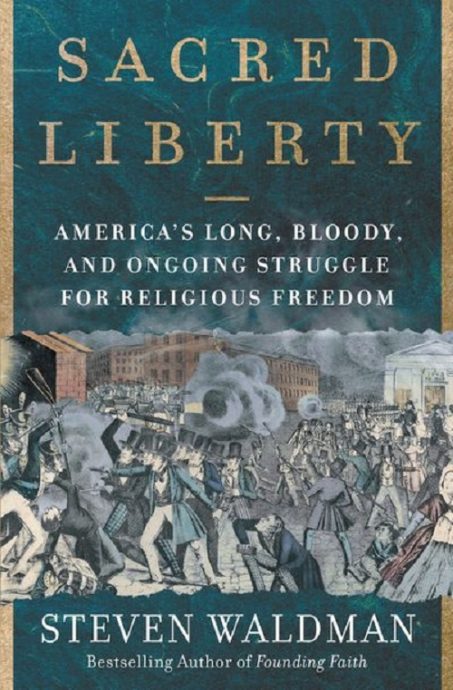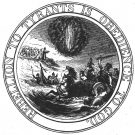A Nuanced Report Card on Religious Liberty
Steven Waldman has produced an excellent overview of the development of religious liberty in the United States. It is well-written, as one would expect of a journalist (the Beliefnet.com founder is a veteran of Newsweek, among other publications), but also well-researched and reasonably nuanced. Experts on particular eras or subjects will find details about which they can justly complain, but on the whole, Sacred Liberty: America’s Long, Bloody, and Ongoing Struggle for Religious Freedom deserves high marks.
Just one of the book’s 18 chapters is devoted to the early colonies. Waldman overstates the extent to which Puritans enforced repressive laws with “sadistic enthusiasm.” Yet he is certainly correct that no colony—not even Rhode Island or Pennsylvania—embraced a modern, liberal conception of religious freedom.
America’s Founders rejected Old World approaches to church-state relations. They shared a commitment to protecting religious liberty, and many Founders were coming to question the efficacy of religious establishments. These views contributed to the adoption of a constitution that banned religious tests for federal offices, and to the crafting of a First Amendment that says, “Congress shall make no law respecting an establishment of religion, or prohibiting the free exercise thereof.”
Jurists and scholars often act as if James Madison and Thomas Jefferson are the only Founders who matter when it comes to religious liberty and church-state relations. Refreshingly, Waldman cautions that Madison “did not alone invent the general concept of religious freedom,” and he notes that even the major Founders differed regarding the extent to which governments should encourage religious practices.
Waldman identifies Madison as a separationist; but this misunderstands the extent to which he was committed to strictly separating church and state. For instance, he writes that Madison “opposed the appointments of congressional and military chaplains, on the grounds that using tax dollars to pay ministers was creating a religious establishment,” and that he “objected when Presidents Washington and Adams issued prayer proclamations.”
As a member of the confederation and federal congresses, Madison voted to pay chaplains, and as the nation’s fourth President, he issued four calls for prayer. After he left the presidency he questioned the constitutionality of these practices, but he did so in a private document that was not published in his lifetime. Even if these were views he held earlier, he did not act on them, and there is little evidence that other Founders (except Jefferson) shared them.
In the popular telling of history, America’s Founders embraced religious liberty and everybody lived happily ever after. This is not the story that Waldman tells. Sacred Liberty includes excellent chapters detailing discrimination against, and even persecution of, Roman Catholics and Mormons in the 19th century and Jehovah’s Witnesses in the 20th. As well, he offers solid accounts of the lack of religious liberty afforded to slaves and Native Americans.
An overlooked landmark in the rise of religious liberty in America is the National Conference of Christians and Jews, founded in 1927. In 1933, three of the group’s leaders, a Protestant minister, Catholic priest, and Jewish rabbi, embarked on a 38-city tour to promote interfaith understanding. Their journey was covered by Time magazine, and their endeavor inspired a host of similar tours by other trios throughout the 1930s.
In the 1930s and 1940s, the Supreme Court began to protect citizens from state laws that hindered their ability to act upon their religious convictions. During the Second World War, civic leaders highlighted religious liberty as a core American value. Anti-Catholicism remained alive and well into the 1940s and 1950s, but John F. Kennedy’s successful presidential bid and the Second Vatican Council (1962-1965) did much to alleviate Protestant concerns.
The Immigration and Naturalization Act of 1965 played an important role in increasing religious diversity in the United States. As of 2017, America had “3,727 synagogues; 2,100 mosques; 810 Hindu temples; 290 Sikh gurdwaras; 2,340 Buddhist centers; 150 Baha’i temples; 60 Afro-Caribbean churches; and 90 Jain worship centers.” Fortunately, by the late twentieth century most Americans had embraced a robust understanding of religious liberty, so the ability of these diverse believers to practice their faiths has been reasonably well protected.
A good example of the widespread support for religious freedom in our time was the nation’s reaction to the 1990 decision in Employment Division v. Smith. In this case, a majority of justices rejected a test that required the strict scrutiny of laws burdening religious citizens. In 1993, Congress passed the Religious Freedom Restoration Act to restore this test. It is noteworthy that the bill was passed in the House without a dissenting vote, was approved 97 to 3 by the Senate, and was signed into law by a Democratic President, Bill Clinton.
Waldman’s book has a mostly happy ending. Religious liberty is well protected today, and legislatures often go out of their way to craft accommodations to protect religious minorities. But he emphasizes that the struggle is not over. Since 9/11, some religious and civic leaders have suggested that Islam is not protected by the First Amendment, and according to a recent poll, 28 percent of Americans favor a ban on the building of mosques in their communities. If we desire to honor the memories of the men and women who sacrificed much to secure religious freedom in this country, we must vigilantly work to ensure that all Americans are able to act according to the dictates of conscience.

